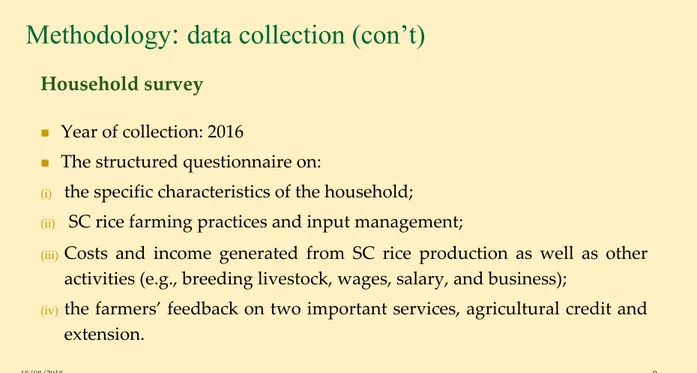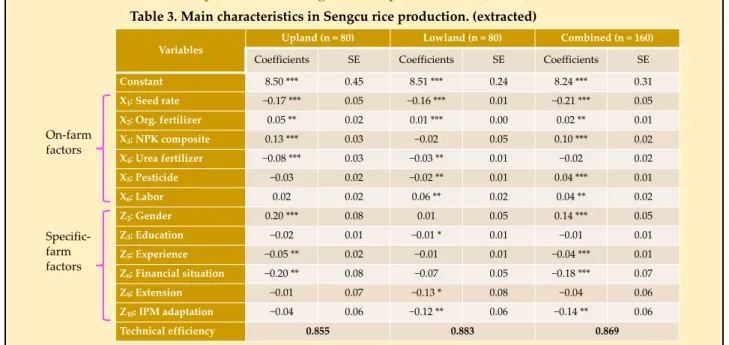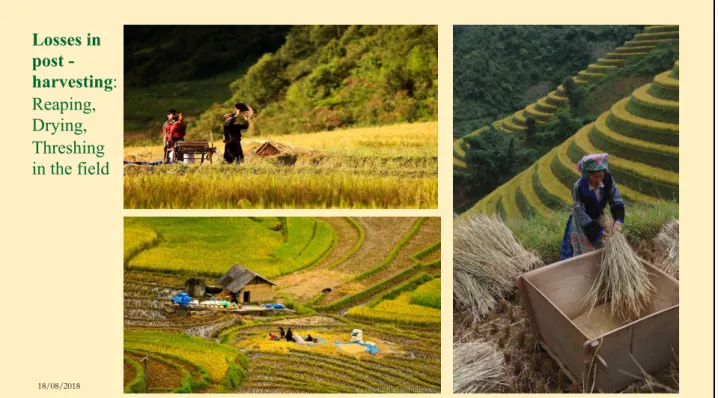PhD student: BUI Thi Lam
Promotor: Prof. Philippe LEBAILLY Instructors: Prof. Philippe BURNY
Dr. HO Thi Minh Hop
18/08/2018 1
Topic: An economic comparison of Sengcu rice production models at farm-level in Laocai province
RESEARCH ON FINANCE FOR AGRICULTURAL VALUE
CHAIN IN MOUNTAINOUS AREAS OF VIETNAM:
A CASE STUY IN LAO CAI PROVINCE
Main Contents
1. Introduction
2. Methodology
3. Main research findings
4. Solutions
1. Introduction
18/08/2018 3
q Laocai province:
• One of sixbroader mountainous provinces; diversity of 25 ethnic
minoritygroups;high poverty rate;
• In 2017, agricultural output accounted 15.6% of GRDP; • Nearly 80% population engaged to agricultural activities; • More 90% of households are cultivating rice.
• The province has many favorable conditions for cultivating SC rice
1. Introduction
q Sengcu rice (SC) production in Laocai • Good variety;
• Cultivated in two kinds of ecological zone (i.e., lowland and upland).
• One of spearhead products because of its high economic value. • However, the share of SC rice remains low and increase slightly
because there are many challenges in production (i.e., pre- and post- harvest) and marketing regarding financing shortage.
Objective
n
An economic comparison of Sengcu rice production between
lowland and upland zones in Laocai province
18/08/2018 5
2. Methodology: Research site
- Selection of districts and communes: the largest areas of SC rice production, existing two kind of ecological zones (i.e. upland/ rain-fed and lowland/ irrigated).
- The number 1 and 2 are lowland communes (Muongvi and Banxen), The number 3 and 4 are upland communes (Lungkhaunhin and Namlu communes).
- Seng Cu is the unique rice specialty in Viet Nam, it has the highest selling price in the domestic market.
https://vnexpress.net/thoi-su/ban-do-cac-loai-gao-dac-san-o-viet-nam-3768497.html (a) (b) (c) (c) 18/08/2018 6
18/08/2018 7
Upland ecological zone: terraced plots
Methodology
:
data collection (con’t)
18/08/2018 9
n Year of collection: 2016
n The structured questionnaire on:
(i) the specific characteristics of the household;
(ii) SC rice farming practices and input management;
(iii)Costs and income generated from SC rice production as well as other
activities (e.g., breeding livestock, wages, salary, and business);
(iv)the farmers’ feedback on two important services, agricultural credit and
extension.
Household survey
Methodology:
data collection
18/08/2018 10
Name of commune Upland
(Rain-fed) (Irrigated)Lowland Total
Muongvi (1) 0 41 41
Banxen (2) 39 39 39
Nungkhaunhin (3) 35 0 35
Namlue (4) 45 0 45
Total 80 80 160
3. Research findings
3.1 Describe the Seng cu rice production in Laocai
3.2 Economic comparison of Seng cu rice production
18/08/2018 11
Farmers’ are facing many challenges, causing low agricultural outputs and threatening sustainable livelihoods.
n Unsuitable farming practice
v Lowlanders overuse chemical inputs to maximum yield à directly increase cost production; reduce the quality and partly damage ecosystem.
v Up-landers invest much lower than the optimum dosages suggested by
extension office because offinancing shortage. n Financing management
q Upland: Financing shortage à inputs trade credit with high interest rate
and sell paddy with lower price.
q Lowland: ineffective investment.
Figure 1: The share of SC rice rice variety 18/08/2018 13 55.1 10.8 27.8 6.3 34.1 2017
High-yield variety Others Other high-quality variety Sengcu rice 69.6 9.3 17.6 3.5 21.1 2012 57.5 14.8 22.7 5.1 27.8 2014 Source: Department of Agriculture of Laocai, 2012 -2017 18/08/2018 14
Items Unit Upland(n = 80) Lowland (n = 80) (n = 160)All T-Test Ratio
Y: Productivity Kg/ha 4,378 5,318 4,848 0.00
X1: Seed rate Kg/ha 55.72 48.00 51.86 0.00
X2: Manure Kg/ha 4324 3833 4078 0.06
X3: NPK Kg/ha 768.2 1019 893.6 0.00
X4: Urea Kg/ha 134.7 138.6 136.6 0.32
X5: Pesticide 000 VND/ha 1209 4082 2686 0.00
X6: Labor Man-day for optional works/ha 37.71 31.51 34.61 0.05
Table 2. Descriptive statistics of productivity and inputs used of SC rice production
3.2 Economic comparison of Seng cu rice production
Variables Upland (n = 80) Lowland (n = 80) Combined (n = 160)
Coefficients SE Coefficients SE Coefficients SE
Constant 8.50 *** 0.45 8.51 *** 0.24 8.24 *** 0.31 X1: Seed rate −0.17 *** 0.05 −0.16 *** 0.01 −0.21 *** 0.05 X2: Org. fertilizer 0.05 ** 0.02 0.01 *** 0.00 0.02 ** 0.01 X3: NPK composite 0.13 *** 0.03 −0.02 0.05 0.10 *** 0.02 X4: Urea fertilizer −0.08 *** 0.03 −0.03 ** 0.01 −0.02 0.02 X5: Pesticide −0.03 0.02 −0.02 ** 0.01 0.04 *** 0.01 X6: Labor 0.02 0.02 0.06 ** 0.02 0.04 ** 0.02 Z2: Gender 0.20 *** 0.08 0.01 0.05 0.14 *** 0.05 Z3: Education −0.02 0.01 −0.01 * 0.01 −0.01 0.01 Z5: Experience −0.05 ** 0.02 −0.01 0.01 −0.04 *** 0.01 Z6: Financial situation −0.20 ** 0.08 −0.07 0.05 −0.18 *** 0.07 Z9: Extension −0.01 0.07 −0.13 * 0.08 −0.04 0.06 Z10: IPM adaptation −0.04 0.06 −0.12 ** 0.06 −0.14 ** 0.06 Technical efficiency 0.855 0.883 0.869 18/08/2018 15
Table 3. Main characteristics in Sengcu rice production. (extracted)
On-farm factors
Specific-farm factors
Note: ***, **, and * indicates the statistically significance at 1%, 5% and 10%, respectively.
3.2 Economic comparison of Seng cu rice production (con’t)
Figure 2: The structure cost of SC rice production
2,408 6,572 1,289 646 11,519 1,803 Upland
Seed Fertilizer Pesticide Operational services Labor cost Depreciation
3,621 7,425 4,082 2,598 6,798 1,176 Lowland
Seed Fertilizer Pesticide Operational services Labor cost Depreciation
Unit: 1000. VND/ha
- Lowlanders invest much higher than uplanders.
- Fertilizers is the main physical cost in both of production models.
- Highlanders have to use much more labor for farming activities without mechanization.
3.2 Economic comparison of Seng cu rice production (con’t)
Losses in post -harvesting: Reaping, Drying, Threshing in the field 18/08/2018 17 Note: figures calculated for 1 kg of dried paddy
IC including the cost of intermediate goods and services
Source: HH survey, 2016
Upland rice: much better quality but its price is slightly higher than others because of their limited capacity of marketing skill and financing shortage.
à Enhance their market knowledge and diversify forms of credit or suitable credit schedule.
Table 4. Economic comparison of Sengcu rice production at farm-level in Laocai Indicators Upland farmers Lowland farmers T-test
Turnover/ Price (VND/kg) 14,920 14,310 0.001***
Intermediate cost (IC) (VND/kg) 2,494 3,569 0.000***
Value Added (VA) (VND/kg) 12.506 11,111 0.001***
% IC 68.44 43.52
% VA 61.32 50.97
3.2 Economic comparison of Seng cu rice production (con’t)
3.2 Economic comparison of Seng cu rice production (con’t)
18/08/2018 19
Jan Feb Mar Apr May Jun Jul Aug Sep Oct Nov Dec Lowland
Upland
Sequential activities: Preparing land Sowing Transplanting Tillering Heading Ripening Harvesting 0 15 30 45 60 75 90 105 130 0 15 30 45 60 75 90 105 120
0 15 30 45 60 75 90 105 120 135
Icons of input usage: See Hired labor Machine services Fertilize Pesticide or Herb Stage of production Costs Days of cropping Stage of production Costs Days of cropping
Figure 3: Crop calendar of SC rice production and cash costs generated in Laocai province Agricultural credit based on the seasonal demand of customers (growers).
4. Conclusions and recommendations
n Farmers:
q Lowlanders has higher the economic benefit than up-landers,
although their quality of rice seems lower.
q Reduce seed rate, nitrogenous fertilizer, and pesticides, concurrently
increasing organic manure and time for applying advanced techniques in order to increase paddy productivity.
n Policy-makers: provide effectively three kinds of agricultural services.
q Irrigation: invest more in uplands.
q extension: update and localize the demand of specific production zone.
Economic value of rice production in mountainous areas in the
Northern of Vietnam
18/08/2018 21
Terraced plots in Batxat, Laocai
Terraced plots in Mucangchai district, Yenbai province
18/08/2018 23
Terraced plots in Mucangchai district, Yenbai province
Source: LE Oanh and BUI Lam, 2018
Terraced plots in Sapa district, Laocai province
18/08/2018 25
https://travel.com.vn/tin-tuc-du-lich/cung-duong-vang-mua-lua-chin-dep-nhat-mien-bac-v10977.aspx




